Visual Prompts and Task Instructions
All task instructions were spoken by the same interviewer, in the language being learned.
INTERVIEW task instructions
The interviewer, who was a native speaker of the language, asked the following questions: What other languages do you speak? How old were you when you started learning [name of language]? Why did you start learning this language? Can you describe typical classes you’ve taken? What did the students do in these classes? What do you do to learn this language outside of class? Have you ever traveled to a country where this language is spoken?QUESTION prompts and task instructions
The interviewer gave a stack of these pictures to the learner and said, “Ask me questions about what you see in the picture, and I’ll tell you the story. At the end, I will ask you to tell the story back to me.”These pictures were drawn for this project by Nora Wildgen White, Minneapolis, Minnesota. They were based on a true story provided by Richard Young.
(Click the thumbnail for a larger image view.)
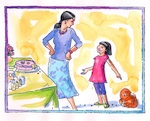
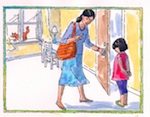


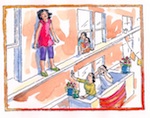
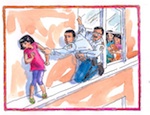

RETELL prompts and task instructions
When the learner had finished asking questions for the Question Task (above), the interviewer said, “Thank you. Now tell the story back to me. You can look at the pictures.”NARRATIVE prompts and task instructions
Each learner was shown a set of four line drawings. These drawings appear in photocopiable form in many second language acquisition research volumes (Tarone, 1989, p. 173; Yule, 1997, p. 68; Tarone & Swierzbin, 2009, p. 163). The interviewer said, “This set of drawings shows a series of events. Look at the drawings and tell me what happened here.”JIGSAW prompts and task instructions
The two learners sat facing each other. Each learner was given a photograph of a different house. The interviewer said, “Each of you has a photograph of a house in Minnesota. Please compare the houses by giving each other information about your photograph or by asking questions. Don’t show each other your photos. For example, you could say, ‘This house has four windows’, or you could ask ‘Is your house in a city?’ Describe the pictures to each other, and find three things that are the same and three things that are different.”Photographs taken by E. Tarone in two St. Paul neighborhoods.
(Click the thumbnail for a larger image view.)

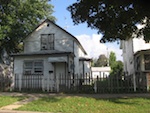
COMPARISON prompts and task instructions
The two learners sat next to each other and the two photos of houses used in the jigsaw task (above) were placed side by side on a table in front of them. The interviewer said, “Please talk about who might live in each house. For example, how many people do you think live in each house? What do you think their social class is? Are these typical houses in Minnesota? What do these kinds of houses tell you about American culture?”
